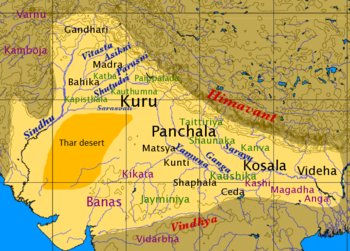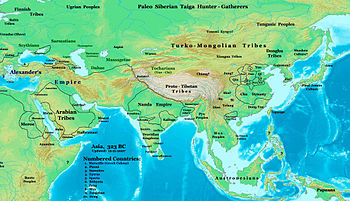The history of India begins with evidence of human activity of Homo sapiens, as long as 75,000 years ago, or with earlier hominids including Homo erectusfrom about 500,000 years ago.
The Indus Valley Civilization, which spread and flourished in the northwestern part of the Indian subcontinent from c. 3300 to 1300 BCE in present-day Pakistan and northwest India, was the first major civilization in South Asia.[2] A sophisticated and technologically advanced urban culture developed in theMature Harappan period, from 2600 to 1900 BCE.
This civilization collapsed at the start of the second millennium BCE and was later followed by the Iron Age Vedic Civilization, which extended over much of the Indo-Gangetic plain and which witnessed the rise of major polities known as the Mahajanapadas. In one of these kingdoms, (Magadha), Mahavira and Buddha were born in the 6th or 5th century BCE and propagated their Shramanic philosophies.
Most of the subcontinent was conquered by the Maurya Empire during the 4th and 3rd centuries BCE. Various parts of India ruled by numerous Middle kingdoms for the next 1,500 years, among which the Gupta Empire stands out. Southern India saw the rule of the Chalukyas, Cholas, Pallavas, and Pandyas. This period, witnessing a Hindu religious and intellectual resurgence, is known as the classical or "Golden Age of India". During this period, aspects of Indian civilization, administration, culture, and religion (Hinduism and Buddhism) spread to much of Asia, while kingdoms in southern India had maritime business links with the Roman Empire from around 77 CE.
Muslim rule started in some parts of north India in the 13th century when the Delhi Sultanate was established in 1206 CE.[4] The Delhi Sultanate ruled the major part of northern India in the early 14th century, but declined in the early 15th century, which saw the emergence of several powerful Hindu kingdoms. In the 16th century Mughal rule came from Central Asia to cover most of the northern parts of India. The Mughal Empire suffered a gradual decline in the early 18th century, which provided opportunities for the Maratha Empire to exercise control over large areas in the subcontinent.[5]
Beginning in the late 18th century and over the next century, large areas of India were annexed by the British East India Company. Dissatisfaction with Company rule led to the Indian Rebellion of 1857, after which the British provinces of India were directly administered by the British Crown and witnessed a period of both rapid development of infrastructure and economic decline. During the first half of the 20th century, a nationwide struggle for independence was launched by the natives irrespective of caste, creed or religion, the leading party being Indian National Congress which was later joined by Muslim League as well.
The subcontinent gained independence from the United Kingdom in 1947, after the British provinces were partitioned into the dominions of India and Pakistan and the princely states all acceded to one of the new states.
Periodisation:
James Mill (1773-1836), in his The History of British India (1817),[6] distinguished three phases in the history of India, namely Hindu, Muslim and British civilisations.[6][7] This periodisation has been criticised, for the misconceptions it has given rise to.[8] Another periodisation is the division into "ancient, classical, medieaval and modern periods".[9] Smart[10] and Michaels[11] seem to follow Mill's periodisation,[note 1], while Flood[12] and Muesse[14][15] follow the "ancient, classical, medieaval and modern periods" periodisation.
Different periods are designated as "classical Hinduism":
- Smart calls the period between 1000 BCE and 100 CE "pre-classical". It's the formative period for the Upanishads and Brahmanism[note 2], Jainism and Buddhism. For Smart, the "classical period" lasts from 100 to 1000 CE, and coincides with the flowering of "classical Hinduism" and the flowering and deterioration of Mahayana-buddhism in India.
- For Michaels, the period between 500 BCE and 200 BCE is a time of "Ascetic reformism"[19], whereas the period between 200 BCE and 1100 CE is the time of "classical Hinduism", since there is "a turning point between the Vedic religion and Hindu religions".[20]
- Muesse discerns a longer period of change, namely between 800 BCE and 200 BCE, which he calls the "Classical Period". According to Muesse, some of the fundamental concepts of Hinduism, namely karma, reincarnation and "personal enlightenment and transformation", which did not exist in the Vedic religion, developed in this time.[21]
| Smart[10] | Michaels (overall)[22] | Michaels (detailed)[22] | Muesse[15] | Flood[23] |
| Indus Valley Civilisation and Vedic period (ca. 3000-1000 BCE) | Prevedic religions (until ca. 1750 BCE)[11] | Prevedic religions (until ca. 1750 BCE)[11] | Indus Valley Civilization (3300–1400 BCE) | Indus Valley Civilisation (ca. 2500 to 1500 BCE) |
| Vedic religion (ca. 1750-500 BCE) | Early Vedic Period (ca. 1750-1200 BCE) | Vedic Period (1600–800 BCE) | Vedic period (ca. 1500-500 BCE) | |
| Middle Vedic Period (from 1200 BCE) | ||||
| Pre-classical period (ca. 1000 BCE - 100 CE) | Late Vedic period (from 850 BCE) | Classical Period (800–200 BCE) | ||
| Ascetic reformism (ca. 500-200 BCE) | Ascetic reformism (ca. 500-200 BCE) | Epic and Puranic period (ca. 500 BCE to 500 CE) | ||
| Classical Hinduism (ca. 200 BCE-1100 CE)[20] | Preclassical Hinduism (ca. 200 BCE-300 CE)[24] | Epic and Puranic period (200 BCE–500 CE) | ||
| Classical period (ca. 100 CE - 1000 CE) | "Golden Age" (Gupta Empire) (ca. 320-650 CE)[25] | |||
| Late-Classical Hinduism (ca. 650-1100 CE)[26] | Medieval and Late Puranic Period (500–1500 CE) | Medieval and Late Puranic Period (500–1500 CE) | ||
| Hindu-Islamic civilisation (ca. 1000-1750 CE) | Islamic rule and "Sects of Hinduism" (ca. 1100-1850 CE)[27] | Islamic rule and "Sects of Hinduism" (ca. 1100-1850 CE)[27] | ||
| Modern Age (1500–present) | Modern period (ca. 1500 CE to present) | |||
| Modern period (ca. 1750 CE - present) | Modern Hinduism (from ca. 1850)[28] | Modern Hinduism (from ca. 1850)[28] |
Prehistoric era[edit]
Stone Age[edit]
Main article: South Asian Stone Age
Isolated remains of Homo erectus in Hathnora in the Narmada Valley in central India indicate that India might have been inhabited since at least the Middle Pleistocene era, somewhere between 500,000 and 200,000 years ago.[29][30] Tools crafted by proto-humans that have been dated back two million years have been discovered in the northwestern part of the subcontinent.[31][32] The ancient history of the region includes some of South Asia's oldest settlements[33] and some of its major civilisations.[34][35] The earliest archaeological site in the subcontinent is the palaeolithic hominid site in the Soan River valley.[36] Soanian sites are found in the Sivalik region across what are now India, Pakistan, and Nepal.[37]
The Mesolithic period in the Indian subcontinent was followed by the Neolithic period, when more extensive settlement of the subcontinent occurred after the end of the last Ice Age approximately 12,000 years ago. The first confirmed semipermanent settlements appeared 9,000 years ago in the Bhimbetka rock shelters in modern Madhya Pradesh, India. Early Neolithic culture in South Asia is represented by the Bhirrana findings (7500 BCE)in Haryana, India & Mehrgarh findings (7000 BCE onwards) in Balochistan, Pakistan.[38][39]
Traces of a Neolithic culture have been alleged to be submerged in the Gulf of Khambat in India, radiocarbon dated to 7500 BCE.[40] However, the one dredged piece of wood in question was found in an area of strong ocean currents. Neolithic agriculture cultures sprang up in the Indus Valley region around 5000 BCE, in the lower Gangetic valley around 3000 BCE, and in later South India, spreading southwards and also northwards into Malwa around 1800 BCE. The first urban civilisation of the region began with the Indus Valley Civilisation.[41]
Bronze Age[edit]
Main article: Indus Valley Civilisation
The Bronze Age in the Indian subcontinent began around 3300 BCE with the early Indus Valley Civilisation. It was centred on the Indus River and its tributaries which extended into the Ghaggar-Hakra River valley,[34] the Ganges-Yamuna Doab,[42] Gujarat,[43] and southeastern Afghanistan.[44]
The civilisation is primarily located in modern-day India (Gujarat, Haryana, Punjab and Rajasthan provinces) and Pakistan (Sindh, Punjab, and Balochistanprovinces). Historically part of Ancient India, it is one of the world's earliest urban civilisations, along with Mesopotamia and Ancient Egypt.[45] Inhabitants of the ancient Indus river valley, the Harappans, developed new techniques in metallurgy and handicraft (carneol products, seal carving), and produced copper, bronze, lead, and tin.
The Mature Indus civilisation flourished from about 2600 to 1900 BCE, marking the beginning of urban civilisation on the subcontinent. The civilisation included urban centres such as Dholavira, Kalibangan, Rupar, Rakhigarhi, and Lothal in modern-day India, and Harappa, Ganeriwala, and Mohenjo-daro in modern-day Pakistan. The civilisation is noted for its cities built of brick, roadside drainage system and multistoried houses.
Vedic period (1500–500 BCE)[edit]
Main article: Vedic Civilisation
See also: Vedas and Indo-Aryans
The Vedic period is characterised by Indo-Aryan culture associated with the texts of Vedas, sacred to Hindus, which were orally composed in Vedic Sanskrit. The Vedas are some of the oldest extant texts in India[46] and next to some writings in Egypt and Mesopotamia are the oldest in the world. The Vedic period lasted from about 1500 to 500 BCE,[47] laying the foundations ofHinduism and other cultural aspects of early Indian society. In terms of culture, many regions of the subcontinent transitioned from the Chalcolithic to the Iron Age in this period.[48]
Vedic society[edit]
Historians have analysed the Vedas to posit a Vedic culture in the Punjab region and the upper Gangetic Plain.[48] Most historians also consider this period to have encompassed several waves of Indo-Aryan migration into the subcontinent from the north-west.[49][50] Vedic people believed in the transmigration of the soul, and the peepul tree and cow were sanctified by the time of the Atharva Veda.[51] Many of the concepts of Indian philosophy espoused later like Dharma, Karma etc. trace their root to the Vedas.[52]
Early Vedic society consisted of largely pastoral groups, with late Harappan urbanisation having been abandoned.[53] After the time of the Rigveda, Aryan society became increasingly agricultural and was socially organised around the four varnas, or social classes. In addition to the Vedas, the principal texts of Hinduism, the core themes of the Sanskrit epics Ramayana andMahabharata are said to have their ultimate origins during this period.[54] The Mahabharata remains, today, the longest single poem in the world.[55] The events of Mahabharata happened in a later period than Ramayana.In fact, there are references of Ramayana in Mahabharata.[56] The early Indo-Aryan presence probably corresponds, in part, to the Ochre Coloured Pottery culture in archaeological contexts.[57]
Sanskritization[edit]
Main article: Sanskritization
Since Vedic times, "people from many strata of society throughout the subcontinent tended to adapt their religious and social life to Brahmanic norms", a process sometimes called Sanskritization.[58] It is reflected in the tendency to identify local deities with the gods of the Sanskrit texts.[58]
The Kuru kingdom[59] corresponds to the Black and Red Ware and Painted Grey Ware cultures and to the beginning of the Iron Age in northwestern India, around 1000 BCE, as well as with the composition of the Atharvaveda, the first Indian text to mention iron, as śyāma ayas, literally "black metal." The Painted Grey Ware culture spanned much of northern India from about 1100 to 600 BCE.[57] The Vedic Period also established republics such as Vaishali, which existed as early as the 6th century BCE and persisted in some areas until the 4th century CE. The later part of this period corresponds with an increasing movement away from the previous tribal system towards the establishment of kingdoms, called mahajanapadas.
"Second urbanisation" (800-200 BCE)[edit]
During the time between 800 and 200 BCE the Shramana-movement developed, from which originated Jainism and Buddhism. In the same period the first Upanishds were written. After 500 BCE, the so-called "Second urbanisation" started, with new urban settlements arising at the Ganges plain, especially the Central Ganges plain.[60] The Central Ganges Plain, were Magadha gained prominence, forming the base of the Mauryan Empire, was a distinct cultural area,[61] with new states arising after 500 BCE[web 1] during the socalled "Second urbanisation".[62][note 3] It was influenced by the Vedic culture,[63] but differed markedly from the Kuru-Panchala region.[61] It "was the area of the earliest known cultivation of rice in South Asia and by 1800 BCE was the location of an advanced neolitgic population associated with the sites of Chirand and Chechar".[64] In this regio the Shramanic movements flourished, and Jainism and Buddhism originated.[60]
Mahajanapadas (600-300 BCE)[edit]
Main articles: Mahajanapadas and Haryanka dynasty
In the later Vedic Age, a number of small kingdoms or city states had covered the subcontinent, many mentioned in Vedic, early Buddhist and Jaina literature as far back as 1000 BCE. By 500 BCE, sixteen monarchies and "republics" known as theMahajanapadas—Kashi, Kosala, Anga, Magadha, Vajji (or Vriji), Malla, Chedi, Vatsa (or Vamsa), Kuru, Panchala, Matsya (or Machcha), Shurasena, Assaka, Avanti, Gandhara,and Kamboja—stretched across the Indo-Gangetic Plain from modern-dayAfghanistan to Bengal and Maharastra. This period saw the second major rise of urbanism in India after the Indus Valley Civilisation.[65]
Many smaller clans mentioned within early literature seem to have been present across the rest of the subcontinent. Some of these kings were hereditary; other states elected their rulers. The educated speech at that time was Sanskrit, while the languages of the general population of northern India are referred to as Prakrits. Many of the sixteen kingdoms had coalesced to four major ones by 500/400 BCE, by the time of Gautama Buddha. These four were Vatsa, Avanti, Kosala, and Magadha.[65]
Upanishads and Shramana movements[edit]
See also: Gautama Buddha and Mahavira
Further information: Upanishads, Indian Religions, Indian philosophy, and Ancient universities of India
The 9th and 8th centuries BCE witnessed the composition of the earliest Upanishads.[66]:183 Upanishads form the theoretical basis of classical Hinduism and are known as Vedanta (conclusion of the Vedas).[67] The older Upanishads launched attacks of increasing intensity on the ritual. Anyone who worships a divinity other than the Self is called a domestic animal of the gods in the Brihadaranyaka Upanishad. The Mundaka launches the most scathing attack on the ritual by comparing those who value sacrifice with an unsafe boat that is endlessly overtaken by old age and death.[68]
Increasing urbanisation of India in 7th and 6th centuries BCE led to the rise of new ascetic or shramana movements which challenged the orthodoxy of rituals.[69] Mahavira (c. 549–477 BCE), proponent of Jainism, and Buddha (c. 563-483), founder of Buddhism were the most prominent icons of this movement. Shramana gave rise to the concept of the cycle of birth and death, the concept of samsara, and the concept of liberation.[70] Buddha found aMiddle Way that ameliorated the extreme asceticism found in the Sramana religions.[71]
Around the same time, Mahavira (the 24th Tirthankara in Jainism) propagated a theology that was to later become Jainism.[72] However, Jain orthodoxy believes the teachings of the Tirthankaras predates all known time and scholars believe Parshva, accorded status as the 23rd Tirthankara, was a historical figure. The Vedas are believed to have documented a few Tirthankaras and an ascetic order similar to the shramana movement.[73]
Persian and Greek conquests[edit]
See also: Achaemenid Empire, Greco-Buddhism, Indo-Greek Kingdom, Alexander the Great, Nanda Empire, and Gangaridai
In 530 BCE Cyrus the Great, King of the Persian Achaemenid Empire crossed the Hindu-Kush mountains to seek tribute from the tribes of Kamboja, Gandhara and the trans-India region.[74] By 520 BCE, during the reign of Darius I of Persia, much of the northwestern subcontinent (present-day eastern Afghanistan and Pakistan) came under the rule of the Persian Achaemenid Empire. The area remained under Persian control for two centuries.[75] During this time India supplied mercenaries to the Persian army then fighting in Greece.[74]
Under Persian rule the famous city of Takshashila became a centre where both Vedic and Iranian learning were mingled.[76] The impact of Persian ideas was felt in many areas of Indian life. Persian coinage and rock inscriptions were adopted by India. However, Persian ascendency in northern India ended with Alexander the Great's conquest of Persia in 327 BCE.[77]
By 326 BCE, Alexander the Great had conquered Asia Minor and the Achaemenid Empire and had reached the northwest frontiers of the Indian subcontinent. There he defeated King Porus in the Battle of the Hydaspes (near modern-day Jhelum, Pakistan) and conquered much of the Punjab.[78] Alexander's march east put him in confrontation with the Nanda Empire ofMagadha and the Gangaridai Empire of Bengal. His army, exhausted and frightened by the prospect of facing larger Indian armies at the Ganges River, mutinied at the Hyphasis (modern Beas River) and refused to march further East. Alexander, after the meeting with his officer, Coenus, and learning about the might of Nanda Empire, was convinced that it was better to return.
The Persian and Greek invasions had important repercussions on Indian civilisation. The political systems of the Persians were to influence future forms of governance on the subcontinent, including the administration of the Mauryan dynasty. In addition, the region of Gandhara, or present-day eastern Afghanistan and northwest Pakistan, became a melting pot of Indian, Persian, Central Asian, and Greek cultures and gave rise to a hybrid culture, Greco-Buddhism, which lasted until the 5th century CE and influenced the artistic development of Mahayana Buddhism.









No comments:
Post a Comment